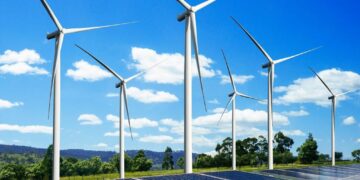Dozens of governments and influential bodies that were formerly opposed to nuclear energy are now openly embracing and hailing it as a necessary player in the global electrification and decarbonization drive.
Uranium markets have lately been on a roll after prices for yellowcake gained more than 20% YTD.
Global uranium production dropped by 25% from 2016 to 2020 amid low prices before recovering slightly to 49,355 metric tons last year.
Uranium and the nuclear energy sector are enjoying a renaissance. There has been a palpable shift in support for nuclear power amid the transition to low-carbon fuels as well as a renewed push to enhance energy security after the global energy crisis triggered by Russia’s war in Ukraine.
Dozens of governments and influential bodies that were formerly opposed to nuclear energy are now openly embracing and hailing it as a necessary player in the global electrification and decarbonization drive. And few have been as monumental as Finland’s Green Party which voted overwhelmingly in 2022 to categorize nuclear power as a form of sustainable energy after decades of strong opposition. A third of Finland’s electricity is generated by nuclear power.
“I am very happy and proud. This is a historical moment in the history of the green movement, as we are the first green party in the world to officially let go of anti-nuclearism.” said Tea Törmänen, a voting member and chair of the Savonia/Karelia chapter of Viite, the pro-science internal group of the party, shortly after the vote.
Other European nations quickly followed suit with Belgium, Spain and Sweden supporting nuclear energy.
Not surprisingly, uranium markets have lately been on a roll after prices for yellowcake gained more than 20% YTD, better than any other metal and topping $65/lb for the first time in 12 years.
Uranium-based investment vehicles and ETFs have performed even better than the metal they track: Global X Uranium ETF (URA) is up 29.2% in the year-to-date; Horizons Global Uranium Index ETF (HURA.TO) has returned 40.3% while VanEck Uranium+Nuclear Energy ETF (NLR) has gained 28.5%. Uranium miners have not disappointed either: Cameco Corp. (NYSE:CCJ)+75.2%, Uranium Energy Corp. (NYSE:UEC)+40.1% and Consolidated Uranium Inc. (OTCQX:CURUF)+30.7%.
Uranium Shortage Bites
But the biggest bullish catalyst yet for uranium bulls has been supply deficits at a time when demand is surging. Global uranium production dropped by 25% from 2016 to 2020 amid low prices before recovering slightly to 49,355 metric tons last year.
The coup in Mali, which produces ~4% of the world’s total, and Cameco’s falling production due to difficulties at its Cigar Lake mine and Key Lake mill in Canada have also constrained supply. Global supplies remain constrained mainly due to years of under-investment in new production, monopoly of state-owned entities, transportation risks and geopolitical uncertainties.
Meanwhile, in its latest biennial report, the World Nuclear Association has predicted that demand for uranium used in nuclear reactors will surge 28% by 2030 and nearly double by 2040 as governments ramp up nuclear power capacity in a bid to meet zero-carbon targets.
Sachem Cove Chief Investment Officer Michael Alkin has told The Wall Street Journal that the uranium market remains “very tight’’ and prices are likely to move even higher heading into 2024. Alkins says he expects utilities to start ramping up talks for uranium conversion and enrichment through private negotiations during the fall or requests for proposals.
Cameco says the dual agendas of clean energy and energy security have so failed to translate into a stronger primary supply pipeline. According to the uranium miner, the uranium market is still in the “relatively early stages of the cycle as uncovered uranium requirements by utilities remains elevated,” and only “sustained long-term uranium demand will ultimately drive the company’s future production plans.”
Cost and Policy Risk
Like all investment theses, uranium bulls will have to contend with some key risks. First off, over the decades, the nuclear sector has become notorious for huge cost overruns by uranium projects. Unfortunately, project managers, financial planners and financiers do not appear to be any closer to solving this conundrum in this age of AI.
Not only has the cost of building new nuclear plants sky-rocketed in recent years but plants currently under construction are massively exceeding cost estimates. A large 3,200 megawatt (MW) plant planned to be built in southwest England by France’s EDF , the world’s largest nuclear operator, is now estimated to cost ~$40 billion, or 30% higher than the initial estimate. Smaller projects are not immune to this problem either. NuScale Power’s 462-MW plant under construction has seen cost estimates increase from $58 per megawatt hour in 2021 to $89/MWh in 2023, a more than 50% jump in the space of just two years.
Second, another major nuclear accident like Three Mile Island or Fukushima might rapidly sour the public sentiment and even force a policy shift. A major thorium breakthrough might spell doom for the uranium sector since thorium reactors do not carry the same risk of a catastrophic meltdown inherent in nuclear reactors powered by uranium.
By Alex Kimani for Oilprice.com
More Top Reads From Oilprice.com:
The Oil And Gas Workers’ Association Endorses Trump For 2024 VoteChinese Fuel Oil Imports Continue To Dip From Decade-HighJPMorgan Analyst Sees Energy Supercycle With Oil As High As $150
>>> Read full article>>>
Copyright for syndicated content belongs to the linked Source : OilPrice – https://oilprice.com/Alternative-Energy/Nuclear-Power/Uranium-Investors-Bet-Big-On-Nuclear-Renaissance.html































